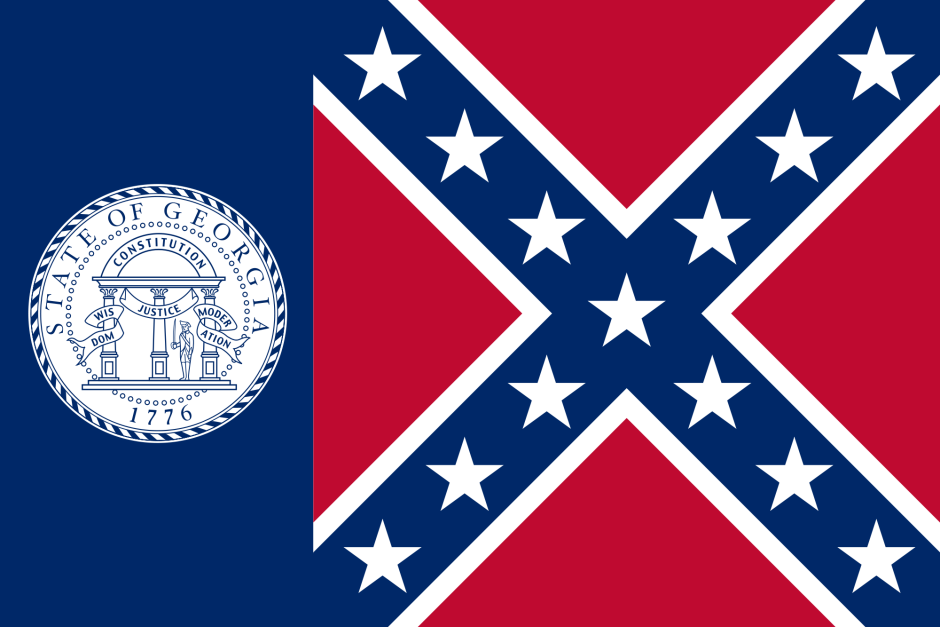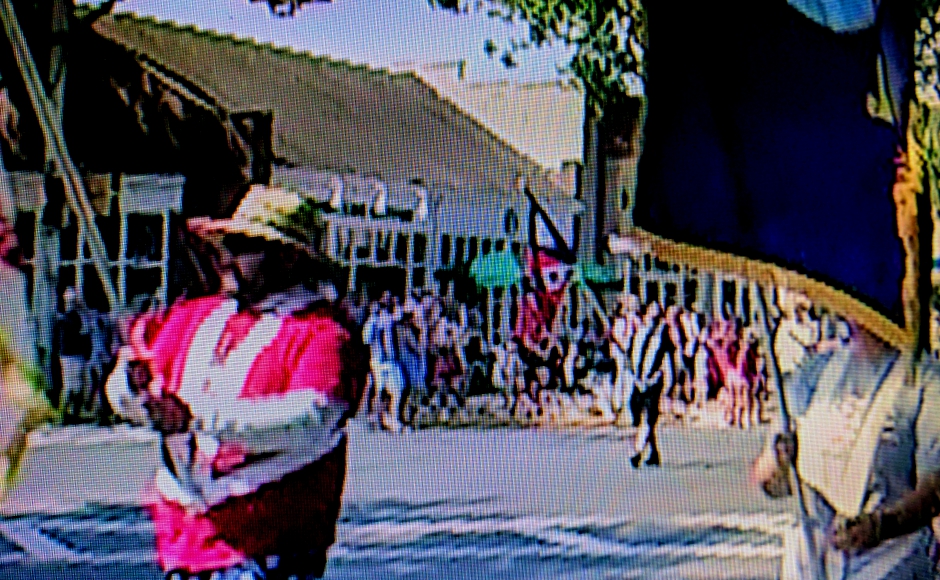A group of pro-life demonstrators has carried a Confederate-inspired state flag in the town parade for years. The act is protected speech, but locals who object would like to meet the marchers and talk it over.
By Matt Skoufalos | July 6, 2017

An unidentified man marching with the Right to Life group carried the 1956 Georgia state flag, a known symbol of segregation, in the parade. Credit: Bob Parsons.
It wasn’t the first time that Margo Kaplan had seen someone carrying a Confederate-inspired flag in the Haddonfield Fourth of July parade, but it was the first time she refused to stay quiet about it.
During the borough’s annual celebration Monday, Kaplan watched as an unidentified man marching with a group of Right to Life demonstrators held aloft what she recognized as the Confederate battle flag.
When she challenged him on it, Kaplan said the man told her he was only carrying the Georgia state flag.
But the version of the flag he displayed was adopted in 1956 by a state legislature “devoted to maintaining the status of segregation in Georgia,” according to a historic self-examination published by the Georgia State Senate in 2000.
The 1956 flag was retired in 2001, and Georgia redesigned its state flag again in 2003 (although the current version still incorporates aesthetic elements of the original flag of the Confederacy). A Georgia couple who flew the 1956 flag along with a Confederate Army flag in a high-profile intimidation case was recently sentenced to prison.
Kaplan said the 1956 flag is a known symbol of oppression, but offered that the marchers “may not be aware that the flag is outdated.” She said she’d like to talk to them about it.
“We would be happy to pay for an up-to-date state flag of Georgia,” Kaplan said.

The 1956 Georgia state flag contains the Confederate Battle Flag, and was adopted during a time when the state legislature challenged civil rights decisions like Brown v. Board of Ed. Credit: Zscout370 via Wikimedia Commons.
George Cox of the Haddonfield Celebrations Association, which puts on the parade, said the event’s organizers find the protestors’ message distasteful.
But there’s little the association can do short of putting the demonstrators at the tail end of the march.
“They show up every year,” Cox said.
“I know it’s freedom of speech, but quite a few of us on the committee don’t know what to do.
“I think we have to talk to these people somehow in a diplomatic way,” he said. “I know this will be a discussion.”
Cox could not immediately confirm the identity of the marchers or their organizers. National Right to Life did not respond to a request to identify the marchers or to clarify the intent of their message.
(UPDATE July 7, 2017: One of the organizers of the march, 79-year-old Tom Fox of Berlin, has said he was unaware that the flag used in the demonstration conveyed a segregationist message. Read that story here.)
Haddonfield Mayor Neal Rochford said he agreed with Kaplan and Cox that the sentiment conveyed by the flag carrier is offensive, but also that there’s little the local government can do to prohibit it.
“If you’re trying to send coded messages of hate or race-baiting, this isn’t the appropriate place for that,” Rochford said. “I’m definitely not for it, it’s the inappropriate place to do it, and if there’s a way we can stop it, we’ll do it.”
Unfortunately, as Haddonfield attorney John Connell pointed out, “the U.S. Supreme Court has said it is the very occasion of offense that warrants First Amendment protection.”
Connell’s opinion carries weight: he chairs the media and communications law group of the Haddonfield law firm Archer, and he’s coming off a 8-0 Supreme Court win in January from a landmark First Amendment decision.

The unidentified man in this video screengrab is carrying the 1956 Georgia state flag in the 2017 Haddonfield Fourth of July parade. Credit: Bob Parsons.
“When Nazis march, when the KKK marches, they have an First Amendment right to do so,” Connell said.
“It doesn’t mean that the citizenry has to tolerate it. It means that the citizenry needs to engage in a fuller dialogue about whether those symbols are offensive.”
Connell said the proper response from those who find the message objectionable is to broker a dialogue with the protestors so both sides can learn more about one another.
He suggested that it might be a task for the borough human relations commission to pursue.
“It gets us back to a point of respectability in public discourse which we desperately need,” Connell said. “That is your catalyst for the public dialogue.”
Kaplan said she’s up for discussing it with the marchers, if they can be located; failing that, she hopes her encounter will open up a broader dialogue about her community and its values.
“Silence isn’t enough,” she said. “It’s never been enough. We shouldn’t stand by in silence when something like this takes place in our town.”
Stick with NJ Pen for updates.



